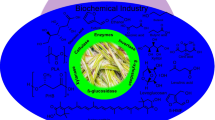Abstract
This article presents the advanced technology that has been developed by BioEnergy International of Gainesville, Florida, utilizing novel recombinant strains of bacteria developed by Lonnie Ingram of the University of Florida. The first commercial applications of these unique fermenting organisms convert 5-carbon sugars, as well as 6-carbon sugars, and oligomers of cellulose (e.g., cellobiose and cellotriose) directly to ethanol. The proposed systems that will be utilized for conversion of agricultural wastes, mixed waste papers, and pulp and paper mill waste in forthcoming commercial installations are now under design. This involves the extensive experience of Raphael Katzen Associates International, Inc. in acid hydrolysis, enzyme production, enzymatic hydrolysis, large-scale fermentation engineering, and distillation/dehydration.
Specific examples of this advanced technology will be presented in different applications, namely:
-
1.
Conversion of the hemicellulose content of sugar cane bagasse to 5-carbon sugars by mild-acid prehydrolysis, followed by fermentation of the 5-carbon sugar extract with recombinantEscherichia coli in a commercial installation soon to be under construction in Brazil. This unique process utilizes the surplus hemicellulose fraction of bagasse not required for steam and power generation to produce ethanol, additional to that from the original cane juice, which has been converted by conventional sucrose fermentation to ethanol. The process also recovers and converts to ethanol the majority of sucrose normally lost with the bagasse fibers. Resultant beer is enriched in an innovative process to eliminate the need for incremental rectification capacity.
-
2.
Application of this technology to mixed waste paper in Florida, with a moderate loading of newsprint (85% mechanical wood fiber), will involve a mild-acid prehydrolysis, the partial extraction of the 5-carbon sugars produced from hemicellulose as a feedstock for propagation of the recombinantKlebsiella oxytoca bacterium. Included is a facility providing for in-house production of cellulase enzyme, as an active whole broth for direct use in simultaneous saccharification and fermentation (SSF) of the remaining cellulose and residual 5-carbon sugars to ethanol. This is followed by distillation and dehydration in the advanced commercially available low-energy recovery system.
-
3.
Another potential application of this unique technology involves utilization of a variety of wastes from several pulp and paper mills in close proximity, permitting collection of these wastes at low cost and reducing the considerable cost encountered in disposing of such low-energy wet waste. Based on pilot plant experiences with converting such waste by simultaneous enzymatic hydrolysis and fermentation, the same techniques will be applied as in the second case, with use of acid prehydrolysis only if the hemicellulose-derived sugars can be economically recovered. If not, acid hydrolysis will be eliminated and only the simultaneous saccharification and fermentation will be carried out, utilizing in-house-produced enzyme broth and recombinantKlebsiella oxytoca.
Similar content being viewed by others
References
Ingram, L. O. et al. U.S. Patent 5,000,000.
Easley, C. E. et al. (1989), Cellulose Waste Conversion, Fed Batch SSF Institute of Gas Technology, 13th Annual Conference.
Katzen, R. (1991), Bio-Conversion of Cellulosic Wastes, AIChE Annual Meeting.
Author information
Authors and Affiliations
Rights and permissions
About this article
Cite this article
Katzen, R., Fowler, D.E. Ethanol from lignocellulosic wastes with utilization of recombinant bacteria. Appl Biochem Biotechnol 45, 697–707 (1994). https://doi.org/10.1007/BF02941841
Issue Date:
DOI: https://doi.org/10.1007/BF02941841




